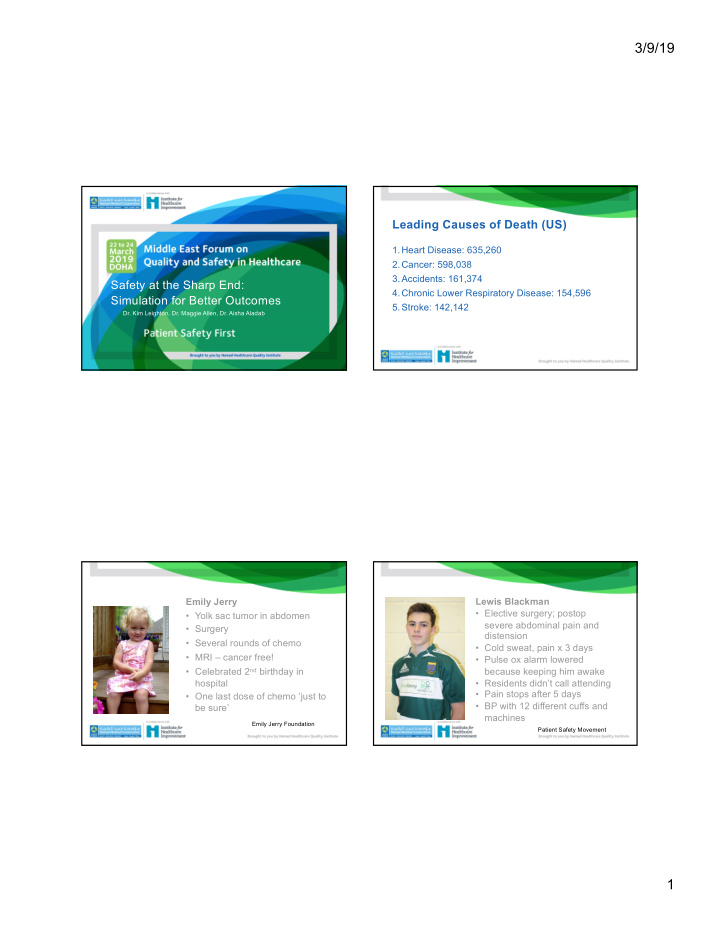



3/9/19 Leading Causes of Death (US) 1.Heart Disease: 635,260 2.Cancer: 598,038 3.Accidents: 161,374 Safety at the Sharp End: 4.Chronic Lower Respiratory Disease: 154,596 Simulation for Better Outcomes 5.Stroke: 142,142 Dr. Kim Leighton, Dr. Maggie Allen, Dr. Aisha Aladab Emily Jerry Lewis Blackman • Elective surgery; postop • Yolk sac tumor in abdomen severe abdominal pain and • Surgery distension • Several rounds of chemo • Cold sweat, pain x 3 days • MRI – cancer free! • Pulse ox alarm lowered • Celebrated 2 nd birthday in because keeping him awake hospital • Residents didn’t call attending • Pain stops after 5 days • One last dose of chemo ‘just to • BP with 12 different cuffs and be sure’ machines Emily Jerry Foundation Patient Safety Movement 1
3/9/19 Josie King • Thirst, really thirsty • 18-months old • Vomiting, diarrhea • 2 nd degree burns over 60% of • Temp 102 her body • Ventilator, central line, dressing • D/C central line - ? Infection changes, skin grafts • Weak, lethargic • Two weeks and out of ICU; • Narcan à no more pain meds close to discharge • Anesthesia worried about • PCA d/c, started on methadone withdrawal; reorders to wean from narcotics methadone Josie King Foundation What are Human Factors? Human Factors ”We can’t change the human condition, but we can change the conditions under which humans work.” James Reason Courtesy of Patrick O Connor and Ken Arnold Hazard Management and the Importance of Human Factors Presentation to the Marine Board 2
3/9/19 The Interaction of Human Factors Human Factors in Incidents Person Error s Violatio ns Development of an Organizational Accident (developed from J. Reason ) Organizational What Can You Do to Help Maintain Challenges Unsafe Acts Situational Awareness? Errors Violations 1. Huddles 2. Briefings Skill Based Perceptual Decision Errors Routine Exceptional Errors Errors 3. Debriefings § Improper work procedure § Breakdown in visual scan § Misapplied skill set § Failed job requirements § Unauthorized work § Misdiagnosed situation § Failed to prioritize focus § Spatial disorientation § Failed to follow direction § Exceeded authority 4. Team communication § Wrong response action § Inadvertent use of controls § Visual illusion § Lack of worker training § Over reaction § Exceeded ability/authority § Omitted step in procedure § Misunderstood task § Breakdown communication § Lack of capability § Inappropriate maneuver Omitted checklist item Misunderstood rules No supervisor oversight Lack of qualification § § § § § Poor decision making § Poor technique or ethic § Poor work environment § Hazard not identified § Except very high risk 5. Monitor the Baseline § Adverse mental state § Over reaction to controls § Miscommunication § Controls in-place not used § Poor planning § Haste or task saturation § Inexperience or capability § Tight time constraints § Substandard work practices § Lack of objectives § Situational awareness § Adverse physiological state § Personal readiness § Pre-existing illness or injury § Unrealistic goals § Failed to use resources § Physical or mental limitations § Work/home distraction § Failure of leadership to act § Under manned/resourced § Hiring the wrong person § Inadequate safety training § Mental complacency § Failure to correct problem 6. Use technology § Fail to track performance Lack of intelligence/aptitude Inadequate reaction time Failed to enforce the rules § § § § Lack skills or qualifications § Inadequate rest breaks § Failed to report unsafe acts § Time pressures § Lack of funding § Excessive cost cutting § No formal accountability Poor equipment design § 3
3/9/19 What is Simulation? What Can We Do to Address Human Factors Violations? “a technique, not a technology, to replace or amplify real experiences with guided experiences, often immersive in 1. Understand your processes nature, that evoke or replicate substantial aspects of the real 2. View your processes through a human factors lens world in a fully interactive fashion” (Gaba, 2004, p. 2) 3. Chose the right strategy 4. Proactively address human factors violations 5. Human Factors Self Assessment Gaba, D. (2004). The future vision of simulation in health care. Quality and Safety in Health Care, 13 (Suppl 1), 2-10. Nov 2012-- Why Simulation? The Value of Simulation • Safe Environment • Lack of Clinical Sites/Cases • Learn from Mistakes Repetition • • Patient Complexity Enhance Teamwork & Collaboration • Improve • • Rules Limiting Skill Performance – Critical Thinking & Clinical Judgment – Organization, Prioritization, & • Limit on Number of Students per Site Communication • Control Types of Patient Experiences • Can Observe Learners More Closely • Faculty/Student Ratio on Clinical 4
3/9/19 26 27 Types of Simulation Role Play Role Play Credit: Monash University Credit: The Doctors Urbanization Simulation Credit: Carrie Mattingly, Twitter 28 29 Credit: SWS Sydney Credit: Inside Hook 5
3/9/19 30 31 Once is Not Enough . . . Reflecting on Your Needs Thank You! • What patient did you think about ? • Dr Kim Leighton, KLeighton@hamad.qa • Why did the medical error occur? • Dr Maggie Allen, MAllen@hamad.qa • What do you want practitioners to learn? • Dr Aisha Aladab, AAladab@hamad.qa • How could simulation help? 6
Recommend
More recommend